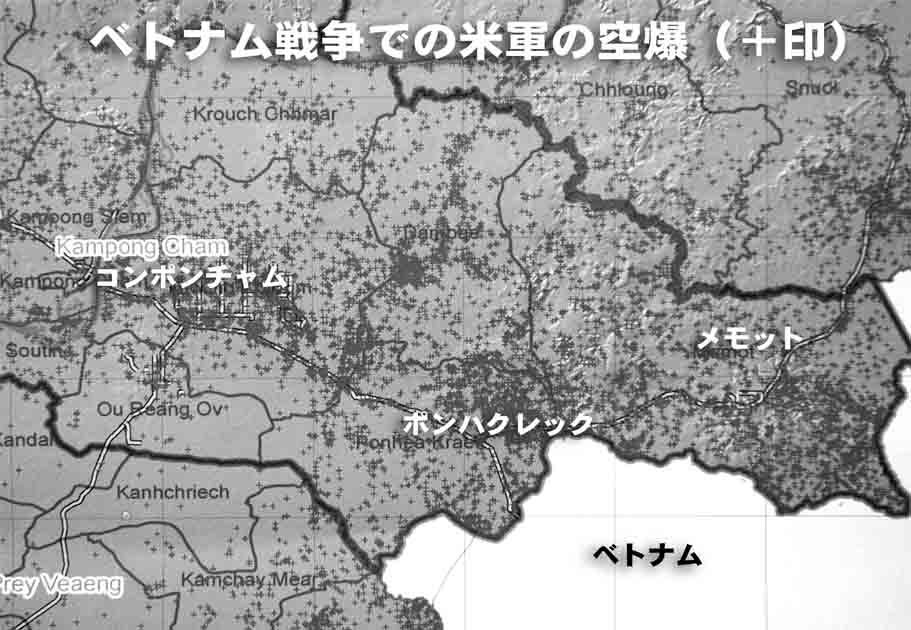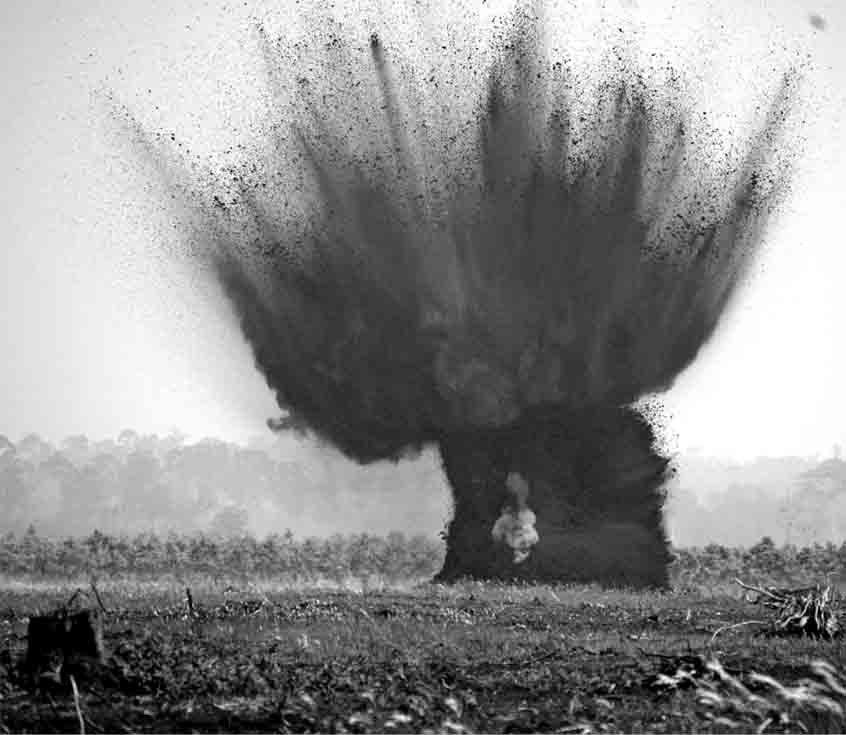Cambodia Mystery of “the Damage from Defoliant”April 2008

A Japanese paper with a national circulation carried a story on February 15th, 2008 with the headline ‘Agent Orange (a defoliant) still lurks in Cambodia’. The story goes that the proportion of babies with disabilities in eastern Cambodia is more than 50 times higher than in other parts of the country, and it is generally believed to result from the use of a defoliant during the Vietnam War. When I read this story, I, in all honesty, doubted the truth of it rather than thought ‘they scooped us’. So first off I made inquiries concerning the newspaper story by telephone or e-mail at the offices in Phnom Penh, including Japan International Cooperation Agency (JICA), which sent Japanese experts on mother and child health care to Cambodia, the Ministry of Health, the National Institute of Public Health, and Cambodian doctors, but they said that they had never heard of it, even a rumor about it. It has been confirmed indeed but only by the experiment on animals that there is a causal relationship between a defoliant containing dioxin and deformity. But recently it has become a commonly accepted view that the effects of defoliant on human body are still unknown. The newspaper story was written on the basis of the local doctors’ statements, but the names of the doctors and their hospitals were not revealed. I thought that if the story was true, I had to make a further detailed report. But if not, I should let it known that there were no such facts. So I went to Cambodia to find out the real facts
Damage by land mines is decreasing, while damage by ERW such as cluster bombs is getting serious.

A Japanese paper with a national circulation carried a story on February 15th, 2008 with the headline ‘Agent Orange (a defoliant) still lurks in Cambodia’. The story goes that the proportion of babies with disabilities in eastern Cambodia is more than 50 times higher than in other parts of the country, and it is generally believed to result from the use of a defoliant during the Vietnam War. When I read this story, I, in all honesty, doubted the truth of it rather than thought ‘they scooped us’. So first off I made inquiries concerning the newspaper story by telephone or e-mail at the offices in Phnom Penh, including Japan International Cooperation Agency (JICA), which sent Japanese experts on mother and child health care to Cambodia, the Ministry of Health, the National Institute of Public Health, and Cambodian doctors, but they said that they had never heard of it, even a rumor about it. It has been confirmed indeed but only by the experiment on animals that there is a causal relationship between a defoliant containing dioxin and deformity. But recently it has become a commonly accepted view that the effects of defoliant on human body are still unknown. The newspaper story was written on the basis of the local doctors’ statements, but the names of the doctors and their hospitals were not revealed. I thought that if the story was true, I had to make a further detailed report. But if not, I should let it known that there were no such facts. So I went to Cambodia to find out the real facts
In the eastern Cambodia, trucks fully loaded with farm products and daily necessities come from and go to Vietnam on the national road, on the both side of which stretch flats of rice fields and rubber plantations. First, trying to find the traces of defoliant, I visited the CMAC eastern regional office, which deals with all kinds of explosive remnants of war (ERW), in Kampong Cham City, the capital of Kampong Cham Province. “I’ve never heard of the damage from defoliant in Cambodia,” said the chief of the office, 46. He seemed dubious of the newspaper story when I told him about it.
“Since we expanded our activities into the eastern part, we’ve never found a so-called chemical weapon, although we found white phosphorus bombs.” Then from a showcase he took out a cluster bomblet whose gunpowder was extracted, as if the newspaper story meant nothing to him. “The explosives of this kind are most dangerous for people. Even more than 30 years after they were dropped, they are live and can explode at once when they are thrown or dropped,” he said. “A bomblet was packed with iron balls of 10 mm in diameter, and if the bomblet explodes, the iron balls are ejected and the people within a radius of 30 meters will be fatally wounded.”

According to the newspaper, the region where many babies with disabilities have been born is Ponhea Krek District and its neighbor on the northeast Memot District, which are located along the border at the eastern end of Kampong Cham Province. In those districts there lie many unexploded bombs and a bomb cemetery. The bomb cemetery is on an unpaved sideway away from the national road. There is nothing but red earth. Not a rubber plantation can be seen. CMAC staff dug a hole 5 meters deep in the ground with an excavator, laid an unexploded bomb with a plastic explosive at the bottom of the hole and filled up the hole again, keeping a blasting fuse outside. Then they heaped up the remaining soil like a wall on the evacuation side. “Move back more than one kilometer. It’s dangerous!” After CMAC staff called out around over the loud speaker, they themselves moved back one kilometer. They connected a leading wire to a generator. With a shout of “Three, two, one!” a member of CMAC turned the crank with all his strength. A pillar of earth shot up more than 50 meters high, and three seconds later a terrific bang cut through the stillness. A cloud of dust was rising up to white clouds in the blue sky. Thus a 250 kg unguided bomb MK82 was disposed.
Memory of happenings on the former Ho Chi Minh Trail
Unlike these unexploded bombs, the defoliant has remained invisible. I went to see a road in Tonle Cham, Memot District. The road was a part of the former Ho Chi Minh Trail running through a jungle, and now it is used as the Cambodian main road. In Tonle Cham there is a river that forms the boundary between Cambodia and Vietnam. On the other side of the river is Loc Ninh, Vietnam. There is nothing but a guardhouse, not a house or a store. But for a national flag with a steeple of Angkor Wat, a radio and a gun in the guardhouse, I couldn’t have realized that here was the border. I saw few tall trees in the surrounding scenery. I didn’t see whether it had been caused by haphazard deforestation or by the effects of the defoliant. “Since the soil is sterile, no crops grow except cassava,” a 49-year-old villager said. He remembered clearly what he had seen when he was 15 years old. “Vietcong fled into our country, and then U.S. forces brought jeeps by helicopter and set up a frontline base around here.” When I asked whether U.S. forces had sprayed defoliant, he said, “I didn’t see a plane spraying it, but I heard roars. The next morning I found leaves covered with powder, and big trees died.”
“Three planes in formation flew along the border and sprayed powder early in the morning. After that, many trees died especially on the side of Vietnam,” said Meng Bang, 69, the village chief of Trameng, who was a guard of the village during the Vietnam War. I asked him about his statement in the newspaper that the powder killed all the trees. Then he said, “The wind blew the powder into this side, and fruit trees including jackfruit died.” This statement does not accord with that in the newspaper.
The past and the present of Preah Pdaw Village
I met Srey Neang, 23, in Preah Pdaw Village, Ponhea Krek District. According to the newspaper story she delivered Siamese twins in 2005. The paper said, “Srey said, ‘My doctor told me my baby was born like this because of my karma, I was so sad.’” She, however, said to me, “I haven’t been discriminated by anyone. On the contrary, everyone sympathized with me.” She told me her bitter experiences with a forced smile. She tried to conceal her grief behind the smile, as is often the case with Southeast Asians.
A 66-year-old woman, who has lived in this village since the time of the Vietnam War, has 12 children, but only one of them was born with a disability. The child, who is now 30, can communicate with his family, but has been practically bedridden because of congenital curvature of spine and limbs. “Have you seen airplanes spraying powder during the Vietnam War?” “Yes, I have. I have seen them in that direction,” she said and pointed toward the border. Judging from the statements of witnesses, U.S. forces indeed sprayed defoliant over the border area in Cambodian territory, but no proof has been found that there is a causal relationship between the defoliant and the deformities of human bodies.
According to the village chief of Preah Pdaw, 65, three babies were born with deformities in the last three years but no baby had been born with deformity before. He had checked the fact in his notebook kept in his house before he told me. A 37-year-old public health nurse, who gives consultations on nutrition and health in the health center with jurisdiction over Preah Pdaw, said that the Japanese newspaper story was quite different from the actual state. “I think defoliant was sprayed mostly on the Vietnam side. We rather worry about chemicals that have been often found in vegetables in recent years. We think they are more harmful.” On the morning when I visited the health center a baby was coming into the world. Besides the health nurse, there is a midwife in the village. If a delivery is difficult, a woman in childbirth will be taken to a doctor in the district hospital or to the provincial hospital, if necessary. The medical system for maternity has already established here. The woman in childbirth had been in the delivery room of the health center for several hours, but she was taken to Ponhea Krek District Hospital by ambulance because she had a difficult delivery, and about an hour later she gave birth to a healthy baby without mishap, though vacuum extraction was done.
‘Statements made by a local doctor’ (?)

The newspaper story that the proportion of babies born with disabilities in eastern Cambodia is more than 50 times higher than that in Phnom Penh was based on the statement made by a local doctor at the province’s central medical center. According to the newspaper, he said, “About 5 or 6 percent of the 200 babies born here each month have deformities.” In Ponhea Krek District, where Preah Pdaw Village is located, there is only one district hospital. I interviewed the director of the hospital, 36, who was supposed to grasp the situation. He said, “95 percent of the women in childbirth have health checkups before delivery, and the numbers of deformed babies, low birth weight babies and stillbirths are each only 2 or 3 in a year. I think maternity education has brought a good result. In 2007 only 3 babies were born with deformities.”
There are only a few hospitals in the local parts of Cambodia. Wealthy Cambodians go to a hospital in Phnom Penh or in a foreign country, so there are no private medical institutions in the provincial areas, and all local medical institutions belong under the public medical system. Most of difficult cases that occur in Kampong Cham Province are brought to Kampong Cham Hospital in the capital of the province. I asked the chief of the obstetric and gynecology, 49, of Kampong Cham Hospital to read the newspaper story in translation that had appeared in an English newspaper. “I see patients every day, but I think this numerical value is a bit too high. We hold workshops, but we haven’t taken statistics of babies born with deformities at all.” He seemed to wonder about the source of the data. “To tell the truth, we have been so busy with saving the lives of mothers and babies that we haven’t made researches into babies born with deformities. However, there was only one baby born with deformity in the last three months, that is to say, one out of 300 babies was born with deformity.” Even in the provincial hospital, which difficult cases are brought in, about 0.3 % of the babies were born with deformities.
The fact that doesn’t appear in the newspaper
The seemingly plausible report in the newspaper had given me a shock, but I couldn’t verify the fact that the number of newborns with deformities was prominently large in the eastern part of Cambodia. I, however, found a fact that Cambodian medical system was being restored steadily, although it would not become news.
